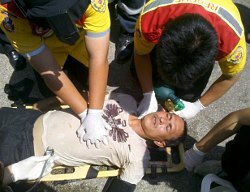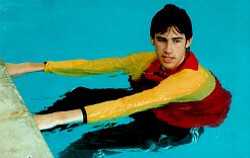Rescues: Spinal Board
The rescue of a casualty with suspected spinal injury is not something you can learn from a website. The delicate skills required have to be learned in the pool. This page shows an outline how to use a spinal board.
Lesson Duration: 90 minutes
Target Audience: Lifeguards, Swim Instructors, and Emergency Response Teams
Learning Objectives:
- Understand the importance of spinal injury management in aquatic environments.
- Learn how to assess and stabilize an injured casualty in the water.
- Demonstrate the correct techniques for extricating and immobilizing a casualty on a spinal board.
- Understand the importance of teamwork and communication during a pool lifesaving operation.
Materials Needed:
- Swimming pool with deep and shallow areas
- Life-saving equipment such as life rings and reaching poles
- Spinal board with straps, head immobilizer and spinal collar
- Rescue tube or buoy
- First aid kit
- Whistle
- Timer or stopwatch
- Towels and blankets
- Full set of clothing for proper realism
Always follow the pool's safety protocols and guidelines.
Ensure that the pool area is properly supervised and that safety measures are in place during all practical exercises.
Lesson Plan
Theory
The theory can be taught in a class room or on poolside. Have everybody dressed for pool action so you don't lose time when going into the water.
Introduction (10 minutes):
- Welcome the participants and introduce yourself.
- Explain the importance of pool lifesaving techniques, especially in dealing with spinal injuries.
- Highlight the learning objectives for the lesson.
Theory Session (15 minutes)
- Discuss the types of injuries that can occur in aquatic environments, with a focus on spinal injuries.
- Explain the potential consequences of mishandling spinal injuries.
- Describe the principles of spinal injury management.
- Review the ABCs of primary assessment (Airway, Breathing, Circulation) and how they apply to pool lifesaving.
Assessment and Initial Approach (15 minutes)
- Discuss the importance of maintaining safety for both the rescuer and the casualty.
- Explain the steps for assessing the situation, including checking for hazards and calling for help.
- Describe the approach to a suspected spinal injury in the water, emphasizing the need to keep the casualty stable.
Immobilization Techniques (20 minutes)
- Demonstrate how to properly use a spinal board, spinal collar, and head immobilizer.
- Explain the role of each immobilization tool and when to use them.
- Allow participants to practice placing a casualty onto a spinal board with the equipment provided.
- Emphasize the importance of maintaining spinal alignment during the extrication process.
Water Practice
Warm-Up Swim (15 minutes)
- Start with a warm-up swim to help participants get comfortable in the water and with their clothing. This prepares them both physically and mentally for the lesson.
- Instruct participants to swim several laps or perform light exercises in the pool to warm up their muscles.
- Emphasize the importance of maintaining proper swimming techniques during the warm-up to prevent injuries.
Extrication Practice (20 minutes)
- Divide participants into pairs or small groups.
- Simulate a rescue scenario in the pool where one person plays the injured casualty with a suspected spinal injury.
- Instruct the other participants to safely extricate the casualty from the water, place them on the spinal board, and immobilize them correctly.
- Rotate roles to ensure everyone has a chance to practice both rescuing and immobilizing.
Teamwork and Communication (10 minutes)
- Discuss the importance of clear and concise communication during a rescue operation.
- Explain how to coordinate efforts with other lifeguards or team members.
- Emphasize the need for continuous assessment and adjustment of the rescue plan as needed.
Scenario-Based Drills (20 minutes)
- Conduct realistic scenario-based drills in the water, involving a simulated spinal injury.
- Participants must work together to assess, stabilize, extricate, and immobilize the casualty safely.
- Provide feedback and guidance as participants complete the scenarios.

Resuscitation

The ambulance has arrived.
Conclusion and Assessment
- Summarize the key points of the lesson.
- Address any questions or concerns from participants.
- Emphasize the importance of ongoing training and practice in pool lifesaving techniques.
- Assess participants' performance during the practical exercises and scenario-based drills.
- Conduct a verbal quiz in the pool to evaluate their understanding of the key concepts covered in the lesson.
Homework and Assignments
- Assign participants to review the principles of spinal injury management
- Research any updates or new techniques in the field.
- Keep up realistic swim training and skills practice.

